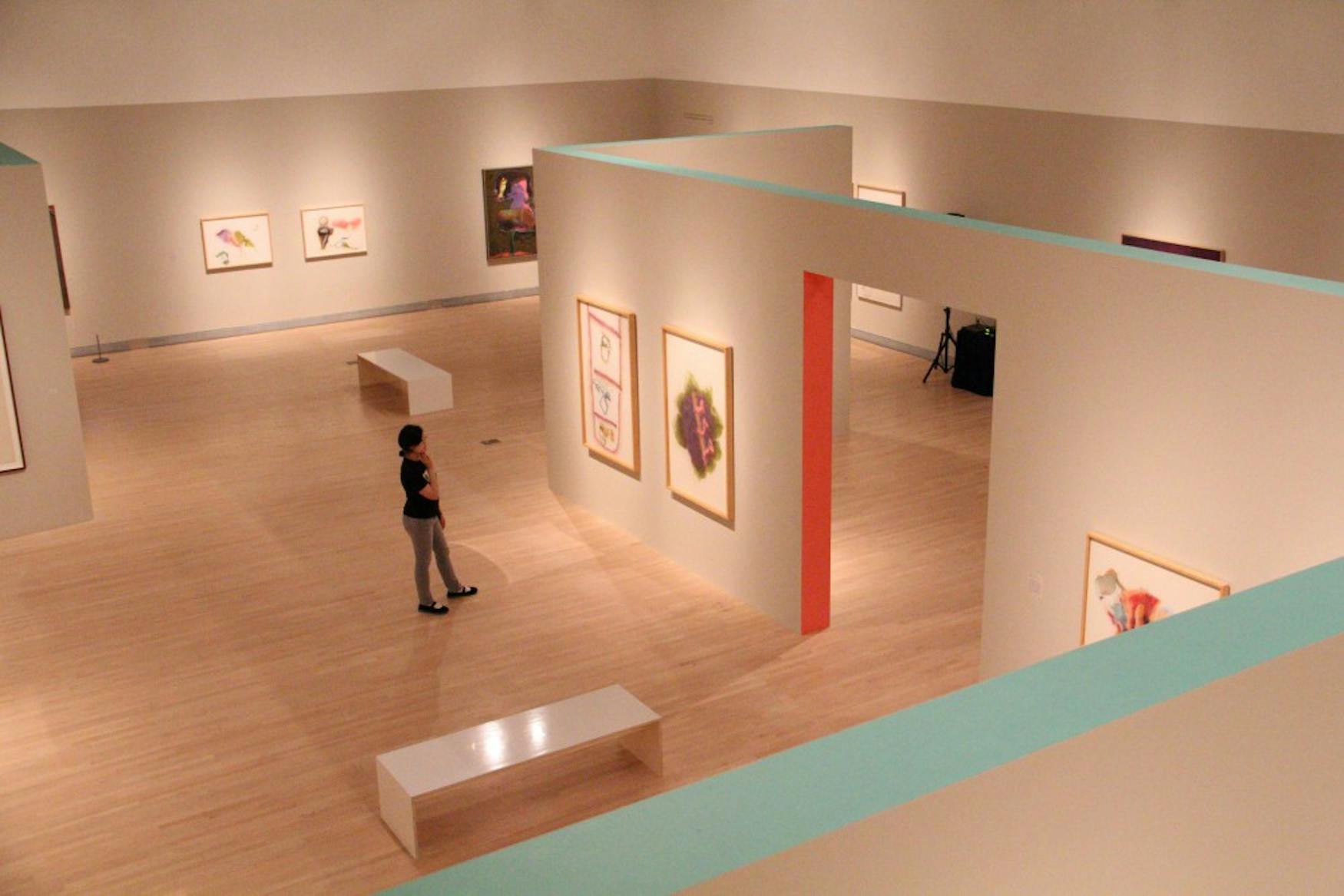‘John Altoon’ reflects artist’s ecclectic style
The Rose Art Museum’s newest exhibit, John Altoon, is a collection of works by the titular artist which opened last Wednesday. The collection is on loan from Los Angeles County Museum of Art, and its exhibit will run through Dec. 21.
The exhibit is ordered chronologically and flows from his earlier abstract and Pop Art works in the ’50s to his pieces on sexual imagery in the later ’60s. The exhibit’s drawings, sketches and paintings feature oil paint, watercolor, airbrush and pastels. Some of the paintings are drawn on canvas, while others are on spare illustration boards that Altoon likely picked up at his job as a commercial illustrator. Altoon frequently contrasts pastels with white backgrounds and uses bright oils against darker backgrounds.
His commercial artistry is most evident in his Pop-Art style works and in his satirical paintings. For instance, one of the artist’s paintings mimics a Colgate toothpaste advertisement.
Although he was one of Los Angeles’s premier artists, Altoon was known as an “artist’s artist.” While painters and illustrators working in the ’60s admired his work, the public was less likely to have heard of Altoon until after his death in 1969.
One of the exhibit’s descriptions mentions how many of Altoon’s pieces could be interpreted through a feminist lens. The women in his drawings are not passive objects, even in paintings focusing on sexual concepts and imagery. The fact that these paintings were crafted during a turbulent time for women’s rights—the ’50s and ’60s saw the rise of birth control and renewed interest in feminist movements—further supports the idea that Altoon’s work could be taking an informed stance on feminism and the beginnings of gender equality.
The Colgate picture mentioned above, “Untitled (F-24)” from 1962-63, depicts a woman and a man standing in front of a nude female figure bound to a cross. Religions often refer to god(s) as male, and in this light, Altoon’s image of the crucified, god-like woman alludes to the idea of female empowerment.
One of the exhibit’s not-to-be-missed pieces is the LIFE Magazine drawing, officially called “Untitled”, from 1964 that features two unnamed men. The drawing is framed like the cover of LIFE magazine, with the red LIFE symbol in the top right corner and a caption at the bottom left. The drawing features two male figures, one dressed in hunting gear and one shirtless, standing side by side in front of a garden landscape. The hunter is holding the lower half of a gun that the shirtless man is bending into a garden hose. The entire scene mimics the infamous “backyard photos,” pictures of Lee Harvey Oswald in his backyard with his rifle that the Warren Commission used to convict him of the assassination.
Underneath the two figures is a dark box encasing the caption, “Tarzan and I were watering the lawn the day it happened. Especially for LIFE by Lee Harvey Oswald.” According to the accompanying blurb at the museum, the caption and the overall appearance of the drawing—with Oswald and Tarzan harmlessly tending to their lawn—are meant “to skewer depictions of the infamous assassin Lee Harvey Oswald.”
The majority of Altoon’s drawings, however, do not have such a clear message. His works can be subtler, as illustrated by the variety of works that walk the line between the imagined world and reality. In “Untitled (Dior: Paris Evenings),” from 1962-63, three men and one woman engage in a dreamlike imitation of a Dior fashion show. Each man is missing an item of clothing, while the female model wears only high heels. The drawing’s inscription is “Paris: Dior Evenings—Sleeved, Straight, Covered,” which is both innuendo and a pun on the figures’ clothing (or lack thereof). The woman’s Jackie Kennedy-inspired hairstyle and the painting’s faded pastel colors evoke a ’60s mood and contribute to the its sense of a hazy reality.
Altoon often adds in his own characteristics to his works, be it with his signature drooping mustache or his bright striped pants. The exhibit includes an untitled watercolor drawing depicting Altoon’s green pants and brown belt, drawn clearly. The images are surrounded with red shapes that are more open to interpretation. The piece’s ambiguity makes observers question how they see and interpret their surroundings.
John Altoon truly offers something for every viewer. For those who love the abstract, abstraction is evident in nearly all of Altoon’s works. Even in his more realistic pieces, parts of Altoon’s figures can be unclear, fade into other elements of the drawing or be drawn so that they resemble multiple objects and leave the viewer to interpret their identity. The exhibit offers political satire and pokes fun of t artists of the time who believed in sticking to one style of work. In contrast, Altoon’s exhibit begs the question: why stick to one form when an artist has a talent for so many?



Please note All comments are eligible for publication in The Justice.